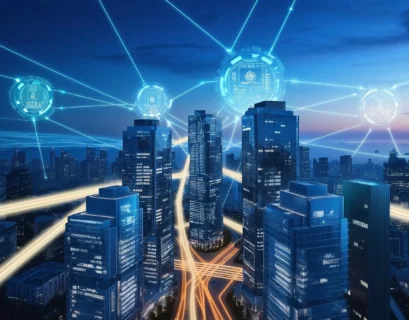Introduction
As we find ourselves deep within the digital age, the relentless pace of technological advancements has reshaped industries and altered the very fabric of everyday life. With the ever-increasing demand for sustainable solutions across various sectors, tech sustainability has emerged as a pressing global imperative. As organizations strive for more robust, efficient, and environmentally-friendly systems, a critical focus has emerged on the notion of core components within technology. Understanding these core components and their integration into sustainable practices will likely determine the trajectory of future development.
In this article, we will explore what core components are, their implications for technology development and sustainability, the innovations driving this change, and the future outlook for tech sustainability.
Understanding Core Components in Technology
Core components refer to the fundamental building blocks and functionalities that support broader technological systems. They can be seen as the essential features that make up software applications, hardware devices, and IT infrastructure. Traditionally, core components are categorized into several layers, including:
- Hardware components: These are the physical systems such as CPUs, GPUs, storage, and networking equipment.
- Software components: This includes operating systems, middleware, application software, and cloud services.
- Data architecture: The manner in which data is collected, stored, processed, and analyzed.
- Integration frameworks: Tools and methodologies that enable different components and systems to interoperate seamlessly.
From IoT devices to AI systems and cloud architecture, the importance of core components cannot be overstated. They provide the capabilities, scalability, and efficiency required to build sustainable, resilient technological solutions.
Industry Insights: The Push for Tech Sustainability
As ecological concerns intensify, various industries are beginning to adopt a sustainability-first mindset. Companies ranging from tech giants to startups are altering their business models to better accommodate social responsibility, environmental impact, and economic viability.
1. Tech Industry Transformation
Tech sustainability emphasizes the need for solutions that minimize resource waste, reduce emissions, and utilize renewable resources. Companies like Google and Microsoft have pledged to operate using 100% renewable energy, showcasing a shift towards sustainability at the core of their operations. The rise of Cloud computing, which enables more efficient resource use through shared infrastructure, serves as the backbone for this transformation.
These organizations recognize that sustainability is not just a regulatory response but also a market differentiator. A survey by Deloitte indicated that 83% of millennial consumers prefer environmentally sustainable brands, showcasing a growing consumer demand for ethical practices.
2. Impact on Development Processes
As development teams embrace sustainability, they are reevaluating the design and architecture of software and hardware. Agile methodologies and DevOps practices are increasingly paired with sustainability goals to create efficient, iterative processes that reduce waste and carbon footprints. By focusing on core components, teams can ensure that new solutions are built on sustainable principles from the outset.
Additionally, industry standards and frameworks, such as the Green Software Foundation, have emerged to help organizations incorporate sustainability into their development processes, ensuring that tech products minimize their environmental impact throughout the lifecycle.
Technical Innovations Driving Sustainability
Several cutting-edge innovations are emerging to facilitate this sustainable evolution in technology. These innovations leverage the core components of technology in ways that positively impact environmental sustainability.
1. Edge Computing
Edge computing represents a paradigm shift from traditional centralized cloud computing to localized processing. By moving data processing closer to the source of data generation (e.g., IoT devices), organizations can dramatically reduce latency and bandwidth usage. This optimization results in more efficient resource management and reduced energy consumption, contributing to planet-friendly outcomes.
As more devices become connected through IoT, the adoption of edge computing paves the way for sustainable smart solutions across industries, including agriculture, healthcare, and manufacturing.
2. Green Software Development
The awareness of the environmental impact of software is leading to the rise of green software development. This approach focuses on optimizing code to minimize energy consumption while achieving computational goals. Techniques such as algorithmic efficiency, performance tuning, and adopting low-carbon software patterns are at the forefront.
Tools and frameworks that assist programmers in assessing and optimizing their code for lower energy consumption are becoming increasingly prevalent. By refocusing on these core software components, developers can ensure that their applications are not only optimized for performance but also contribute positively to the planet’s health.
3. Modular Hardware Design
Modular designs in hardware, where components can be easily upgraded or replaced, foster a more sustainable lifecycle. By reducing e-waste and increasing the longevity of devices, manufacturers can meet consumer demand for sustainable products. Companies such as Fairphone and Framework Laptop are pioneering this trend, demonstrating that consumer electronics can significantly minimize their environmental impact while remaining high-performing.
Employing core components like standardized modules allows users to repair, upgrade, and customize hardware for longer use, hence promoting a circular economy model in technology.
4. Artificial Intelligence and Machine Learning
Artificial Intelligence (AI) and Machine Learning (ML) technologies are revolutionizing various sectors, and their applications in sustainability are equally profound. Optimization algorithms can analyze resource consumption patterns, enabling businesses to optimize their operations for energy efficiency. AI models can predict demand accuracy, reduce waste, and optimize supply chains, further illustrating the importance of core data architectures in enabling sustainable outcomes.
A notable example is the use of AI in smart grids for energy distribution. By analyzing real-time data, these systems manage consumption, reducing waste and emissions while ensuring reliability.
Future Outlook: Balancing Innovation with Responsibility
The principles of sustainability in technology development will continue to dominate discussions among futurists, developers, and entrepreneurs alike. As we look forward, several prominent trends and predictions provide insight into the potential future of tech sustainability.
1. Increased Regulation and Standards
With growing public concern over environmental impact, governments worldwide are set to establish stricter regulations and standards for technology companies. Businesses that prioritize core components aligned with sustainability will have a competitive advantage. Creating transparent processes and sustainable practices will become essential for compliance and reputation.
2. Investment in R&D for Sustainable Technologies
As organizations aim to align with sustainability goals, investment in research and development focusing on green technologies will be crucial. Core components guiding this research—such as renewable energy technologies, energy-efficient computing, and sustainable materials—will drive innovation in tech sustainability.
3. Emphasis on Life Cycle Assessment and Circular Economy Principles
The need for businesses to assess the entire lifecycle of their products will become a crucial factor in achieving sustainability. By evaluating raw material sourcing, manufacturing processes, usage efficiency, and disposal/repurposing practices based on core components, companies can minimize waste and environmental impact effectively.
The transition to a circular economy approach, where tech products are designed for longevity, repairability, and recyclability, will become integral to tech strategy.
4. Convergence of Technologies
The integration of various technologies—such as AI, IoT, blockchain, and renewable energy systems—will lead to innovative solutions for sustainability. By leveraging the core components of each technology together, businesses can provide comprehensive solutions to complex societal challenges, such as climate change and resource scarcity.
Conclusion
In navigating an increasingly complex technological landscape, the concept of tech sustainability is not merely a trend; it is becoming a fundamental precept of future development. By focusing on the core components of technology—hardware, software, data architecture, and integration—we can create robust, sustainable systems that align with the urgent need for environmental responsibility.
Organizations that make core components a priority in their sustainable initiatives stand to benefit not only from compliance with emerging regulations but also from enhanced operational efficiencies and market differentiation.
As industries continue to innovate and embrace these principles, the future of development promises to be marked by creativity and responsibility, ultimately contributing to a healthier planet. The road ahead will require collaboration, transparency, and relentless pursuit of improvement in both technology and sustainability, as we strive to reshape our digital future.


















